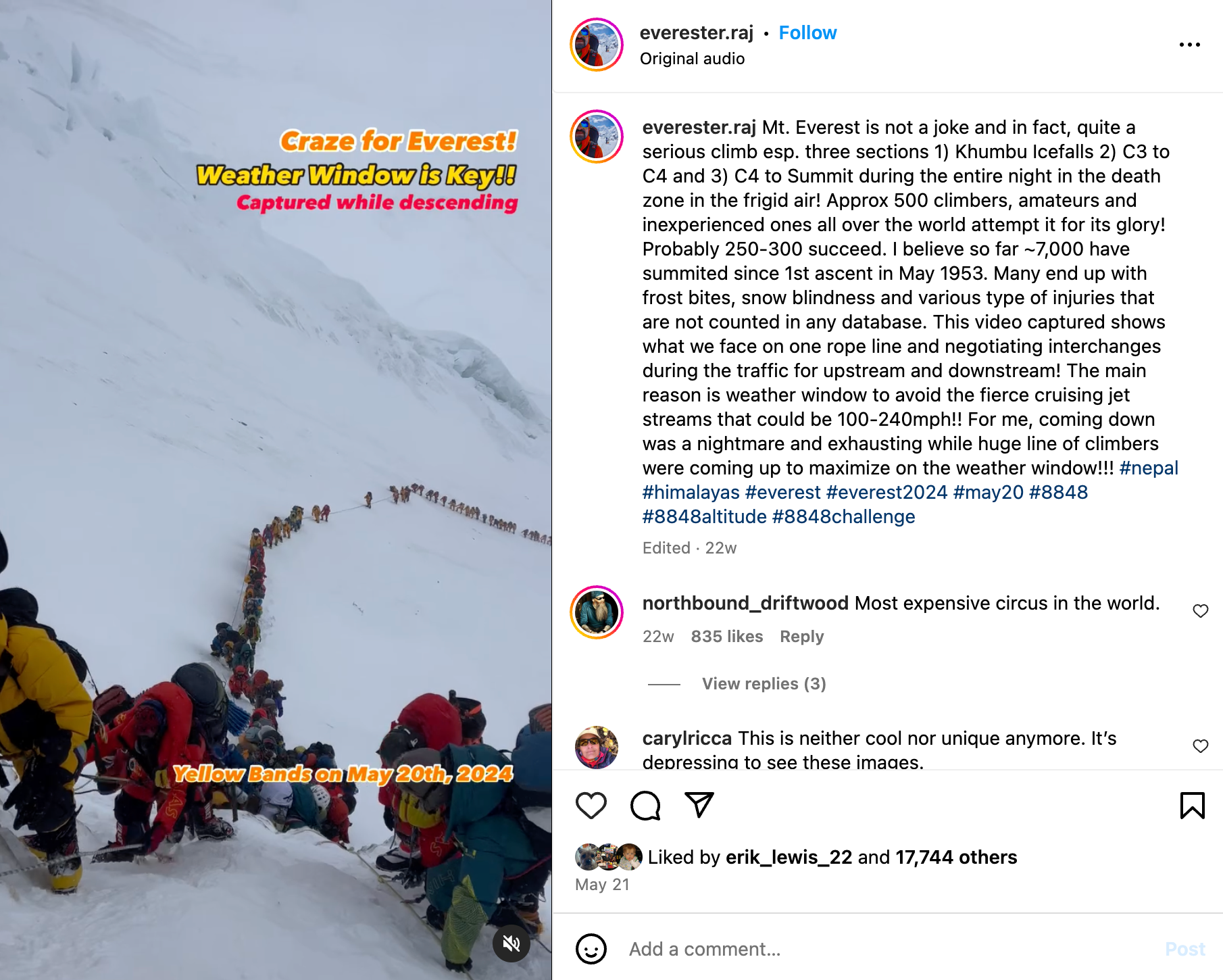We’ve probably all seen the photo by now. The cover shot of a National Geographic story from a couple weeks back is of Jimmy Chin crouching over a rotting boot on a glacier, peering enigmatically into the camera. Chin and his team apparently proceeded to “[run] in circles dropping F-bombs,” because this boot (and the frozen foot inside it) belonged to Andrew Comyn Irvine, a 22-year-old better known as “Sandy.”
Almost exactly 100 years ago, young Sandy and his partner, George Mallory, disappeared while attempting to summit Everest (8,848m), the world’s tallest mountain. Everest would not be climbed definitively for another three decades, by Edmund Hillary and Tenzing Norgay.
Mallory and Irvine vanished when they were quite close to the summit—less than 1,000 vertical feet—so in the decades since, questions remained as to if they topped it out before expiring.
Most experts who’ve dug into the enigma have come away with the conclusion that the men could not have made the top. Chiefly, these doubts are because of a challenging rock feature on the final ridge, the Second Step, which would have been extremely difficult to climb with the gear available in 1924: leather boots, flax rope, wool and cotton apparel. The Second Step is rated 5.7 by today’s technical rock standards, making it the highest rock climb in the world.
While today’s climbers use fixed ropes and ladders to skip the feature, it’s unclear how Mallory and Irvine would have overcome this obstacle. It would’ve been pretty damn hard. Conrad Anker, who discovered Mallory’s body in 1999 and was the first person to free climb the Second Step with Leo Houlding in 2007, stated that he found it “possible, but highly improbable, that [the men] made it to the top.”
Despite Anker’s discovery of Mallory, Irvine remained missing for the next 25 years. Now he (or at least his foot), has been found, too. We don’t know exactly where, though. Chin has not publicly released that information, to avoid swarms of goons and clout chasers—probably a smart idea.
Nat Geo‘s writer Grayson Schaffer called the Mallory and Irvine disappearance, and the question of whether or not they reached the top, “the greatest climbing mystery of all time.” In the most clear sense of the word “great,” he’s probably right. But in another sense, I’m not sure any of this is so great.
For one, a summit is about more than reaching the top. It’s also about getting down. (Mallory and Irvine certainly did not.)
But perhaps more importantly, it’s also about how you climb the mountain, and why. Let’s hear from Mallory himself. When asked why he wanted to climb Everest, his response was, “For the spirit of adventure, to keep alive the soul of man.”
He said more:
There is not the slightest prospect of any gain whatsoever … We shall not bring back a single bit of gold or silver, not a gem, nor any coal or iron … If you cannot understand that there is something in man which responds to the challenge of this mountain and goes out to meet it, that the struggle is the struggle of life itself upward and forever upward, then you won’t see why we go.
What we get from this adventure is just sheer joy. And joy is, after all, the end of life. We do not live to eat and make money. We eat and make money to be able to live. That is what life means and what life is for.


George Mallory (left) and Andrew Irvine (right).
Mallory and Irvine were explorers. They went up into the unknown, unsure of success, unsure of survival. They never came back. But they responded to the challenge. Did they summit? Did they not? Where did they die, and how?
It doesn’t really matter anymore.
Flash forward 100 years, and Everest is a cesspit. It may still be the first thing that comes to mind when your grandmother thinks of “climbing,” but for most, the mountain has become the stomping ground of influencers and doctors and hedge fund managers and CEOs and other wankers.
Everest Base Camp has become a place where people learn how to put on a harness, how to walk in crampons, how to jug a fixed rope, and how to stand in a line. It is a place of sexual assault and trash and feces. It is a place of selfies and follower counts and sponsored promotional posts. It is a place of buzzing drones and incessant helicopter flights. Last year, nearly two-dozen climbers took helicopters from Camp II to Base Camp as a “shortcut” on the way down.”
People are not responding to a challenge, but chasing an accomplishment.
Everest is a notch in the belt first, and a challenge second. (Or perhaps third, or seventeenth.) It is something to put in your Instagram bio, maybe to impress that hot secretary at your white collar job. It is today—in direct contrast to Mallory’s words—where many come precisely to “gain” something, to chase gold and silver, the “gems” of sponsorship and influence and fame.


The world’s highest backflip? Queueing at Disneyland, or climbing Everest? CREDIT: Devon Lévesque / Rajan Dwivedi
If Mallory and Irvine are looking down at us, I’m not sure they are caring much about anyone discovering their bodies or their feet or their oxygen canisters, or deciding when and where and how and why they died 100 years ago.
I would imagine, instead, that they are looking at this poisoned mountain and wondering why permit numbers have not been dramatically capped, why higher standards of experience and skill and fitness are not required by outfitters to join 8,000-meter expeditions, why women are dying (literally) to claim arbitrary “firsts,” and why an Instagram model with 1.5 million followers who’s only climbing experience is a hike up Kilimanjaro is a shoe-in for an Everest team.
The latest UN Emissions Gap Report indicates at the current rate, global greenhouse gas emissions “will produce future mean temperature rises of between 2.6 and 2.8 Celsius (4.7 to 5 Fahrenheit) by mid-century, and 3.1 Celsius (5.6 Fahrenheit) by 2100.” A round-trip economy class flight from Chicago to Kathmandu emits nearly 3.5 metric tons of CO2. That is almost four times the carbon an average African emits in an entire year.
I would imagine Mallory and Irvine are wondering why a scalable carbon tax is not applied to Everest attempters, based on how far they’ve flown to arrive and how far they will fly to return.
I write for Climbing magazine. Every year, we do a series of “April Fools” articles. Two years ago I wrote this one, about a fully-contained space suit-style climbing apparatus I dubbed the “AlpineComfortMAX.”

This fictional suit, I wrote, was “temperature-regulated, with the average internal temperature capped to drop no lower than 60℉, regardless of the altitude or external temperature, with a pressurized spherical headpiece that provides 360-degree visibility without letting in any outside air…
“The headpiece itself is designed to offer augmented reality functionality. A variety of apps can be programmed into the headpiece and viewed on the heads-up display, from useful utilities like Gaia GPS and The Weather Channel to leisure applications like Netflix and Hulu. Climbers can easily binge their favorite TV shows, whether they’re queuing in fixed lines on the side of the mountain or huddling in their tent at night, all right from the comfort of their ACM…”
“An attached sustenance tube regularly supplies the climber with water and food as they climb, all hands-free. Although this early prototype version will only supply [the wearer] with basic food and drink, such as energy gels, nutrition shakes, and water, [the designer] is confident that eventually, the ACM will be able to accommodate hot beverages, such as coffee, soup, or hot chocolate…
You get the idea. I really laid it on thick. It was an outrageous, lunatic absurdity. Within a few days, I received a message from a man on Facebook.
“Hello sir, It was a pleasure to have read your work on the world’s first climbing suit. Would you happen to have [the designer’s] contact information that you could share? I work within the space industry and as an experienced climber I trekked to Mt. Everest base camp last November and have been petitioning my contacts with spacesuit designers to have me test their prototype spacesuits on the mountain. But it sounds like [the] AlpineComfortMAX would be a better fit.”
Needless to say, I did not respond to this query. It horrified me.
The spirit of adventure, what Mallory was chasing, does not grow on the summit of a mountain or amid the rapids of a river. It grows inside of us and it balloons out of us, and its tendrils run through our culture. We, as a collective—by the places we go and the things we say and post and who we support and follow and how we spend our money and a million other things—choose what the spirit of adventure looks like.
If I were Mallory and Irvine, I would be wondering why my descendants were more obsessed with my 100-year-old, rotting foot than the words that came out of my mouth when I was alive.
